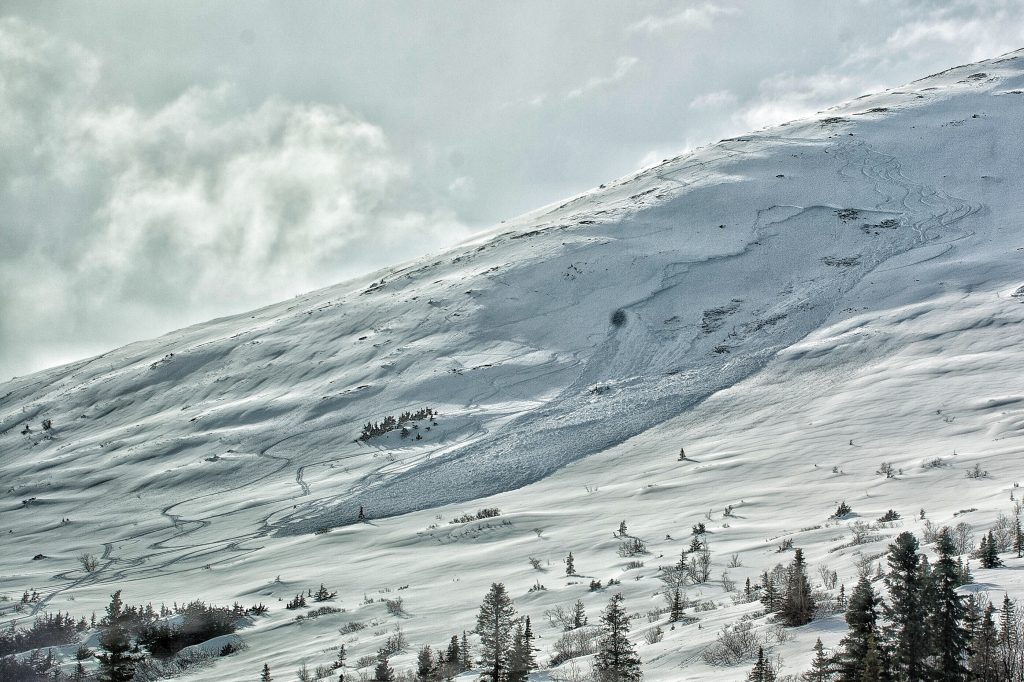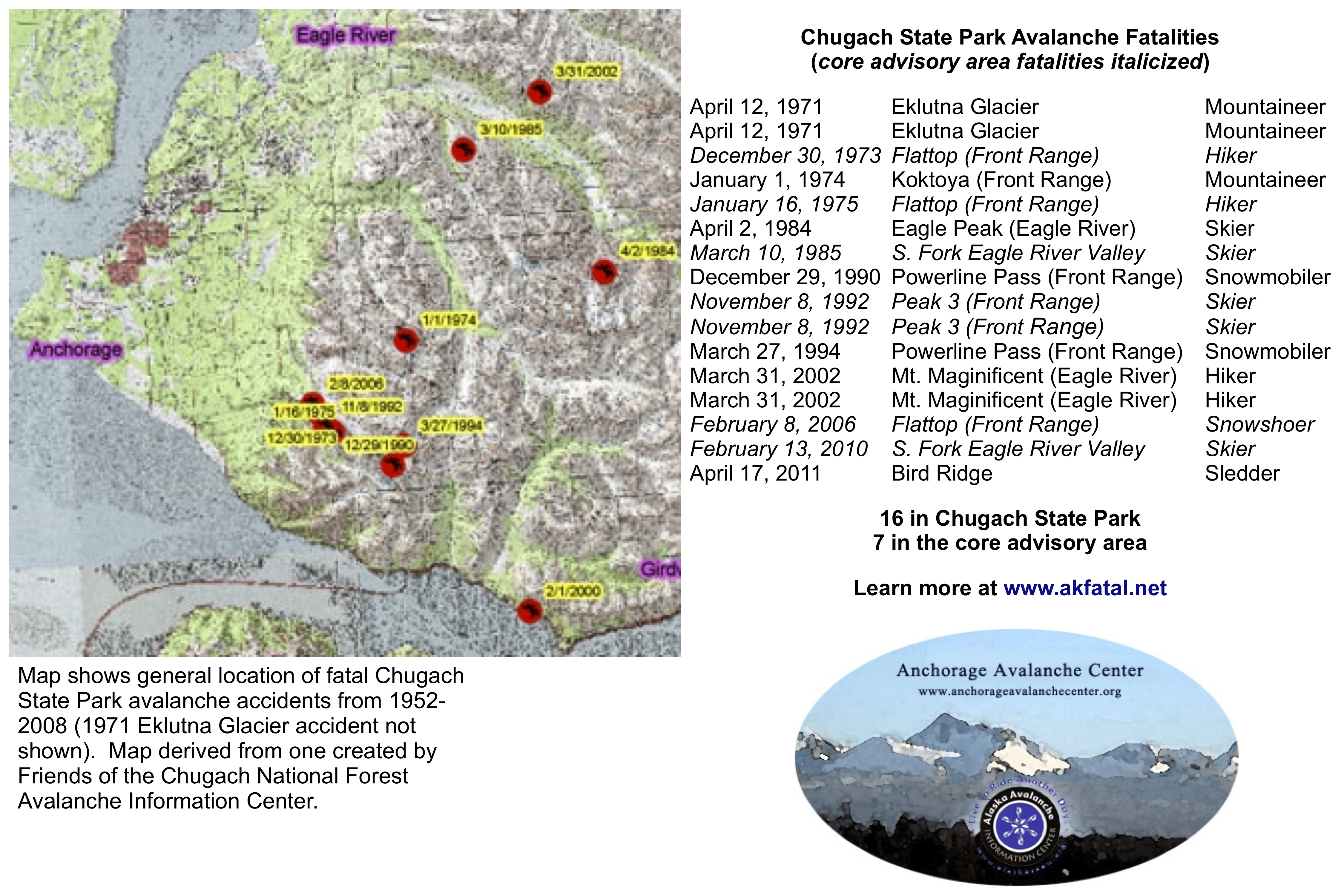As a volunteer, grassroots, and pro bono effort; the Anchorage Avalanche Center has been exploring the most efficient and effective ways to provide avalanche information for the greater Anchorage area Western Chugach Mountains (i.e. Chugach State Park) for the past decade.
The State of Alaska, manager of the land for which we forecast and provide information, has not been able to provide (due to lack of experience, protocols, and willingness to allocate funding for) an avalanche information program for Chugach State Park (or any other state-managed public lands).
The only well-funded avalanche center in the state, the Chugach National Forest Avalanche Information Center (CNFAIC) which forecasts for Turnagain Pass along with their partners at the Alaska Avalanche School, has worked against this project. Their actions over the past decade have evidenced that this is because they act as “The Establishment,” wanting to control how things are done and have a sense of entitlement to all funding and resources flowing through Anchorage when it comes to avalanche programs.
The Anchorage Avalanche Center isn’t the only program “The Establishment” has worked against; they also worked against the Alaska Avalanche Information Center (an Alaskan non-profit organization operating on an alternative model to provide avalanche information for state lands in the Valdez, Cordova, Haines, and Eastern Alaska Range regions).
The unfortunate reality is that if the CNFAIC had worked with rather than against these alternative and independent avalanche programs, Chugach State Park and other state-managed lands would have developed sustainable avalanche programs by now. But, rather than fostering (perhaps more efficient and effective) alternatives to the federal Forest Service model, the CNFAIC has chosen to take actions over the past decade to ensure these models fail.
Dealing with a decade of “The Establishment” working against our program has been beyond frustrating, draining, and hurtful. Nevertheless, we are committed to continuing to provide this service for our community. However, it will again be a different iteration this season.
We don’t have the capacity or funding for regular programming but we will provide avalanche danger updates (under the FORECASTS tab) as warranted by conditions, as well as seeking to provide a general danger rating for avalanche conditions in Chugach State Park on as many days as possible via a multi-day experimental forecast. Observational updates will also be provided via our social media (Instagram and Facebook) as often as possible.
Learn more about the aforementioned history via this paper, which was presented at the 2014 International Snow Science Workshop.
Alaska Backcountry Center mission:
- Enhance the safety, awareness, and enjoyment of visitors to Anchorage’s backyard mountain playground (the Western Chugach Mountains of Chugach State Park) and other Alaskan wilderness venues.
- Promote public lands, sustainable outdoor recreation, ecological consciousness, and environmentally responsible behavior.
- Contribute to Alaskan backcountry/mountain culture.
Alaska Backcountry Center vision:
- Comprehensive outdoor and environmental information and education for Alaska, with phase one being the establishment of a sustainable avalanche information program for the Western Chugach Mountains of Chugach State Park.
- An Alaskan citizenry that recognizes the immeasurable value of its public land, engages in sustainable outdoor recreation for individual and collective wellness, works toward sustainability in all domains of life, practices environmentally responsible behavior, and possesses an imminently necessary ecological consciousness.
- An inclusive, supportive, diverse, and equitable Alaskan backcountry/mountain culture.
Values & Philosophy
Diversity, equity, community, innovation, consciousness, excellence, and FUN.
The fate of the human species is dependent on changing the way we live on this planet. Our current rate of resource consumption and waste is unsustainable, and modern civilization has distanced humanity from its evolutionary heritage in the natural world. Outdoor recreation is an effective means of reconnecting individuals and communities to their natural heritage, developing a more caring relationship with the Earth, and inducing states of ecstasy!
Forecasts: avalanche forecasts and danger updates for the Western Chugach (with an emphasis on the most popular snow-season recreation areas in Chugach State Park)
Observations: recreational conditions in the greater Anchorage area (focused on snowpack conditions in the Western Chugach but inclusive of trail, climbing, and riding conditions throughout Alaska)
Education: statewide learning opportunities and online resources for getting “avy savvy”
Trip Reports: inspiration and stoke that contributes to Alaskan mountain culture
Gear Reviews: our favorite equipment that makes big days in wild Alaskan mountains possible
 Close call: three people were caught and carried by this avalanche just above the South Fork Eagle River trailhead (photo by Suzie Mauro, edited by AAC).
Close call: three people were caught and carried by this avalanche just above the South Fork Eagle River trailhead (photo by Suzie Mauro, edited by AAC).Our primary staff (Mat Brunton) spent November through January of the 2019-2020 season exploring the terrain, snowpacks, and avalanche information programs of Canada, Montana, Wyoming, and Utah. This continuing professional development trip made something very clear: there are currently two avalanche information paradigms for North America (Lower 48 and Canadian), but we need a third (Alaskan).
The United States Forest Service (USFS) has defined the Lower 48 paradigm and it works there, but it does not work in Alaska. Unlike the Lower 48, where the majority of public recreation in avalanche terrain occurs on land managed by the USFS, most of the popular areas (i.e. Chugach State Park, Hatcher Pass, Thompson Pass, Eastern AK Range) for snow-season backcountry recreation in avalanche terrain in Alaska are on state-managed land.
There is only one USFS avalanche center in Alaska (the Chugach National Forest Avalanche Information Center [CNFAIC] based in Girdwood), it forecasts for a relatively small area (Turnagain Pass), but has many times more funding than the other seven (non-government) avalanche centers in the state (Anchorage, Hatcher Pass, Valdez, Eastern Alaska Range, Haines, Juneau, and Cordova) COMBINED.
The minimalist and grassroots model of the Anchorage Avalanche Center could function sustainably with a seasonal budget that is only one-third to half of a State Park Ranger’s annual salary. This project has proven that a seasonal operating budget of only $20,000-30,000 is necessary for long term sustainability.
Considering drastically increasing snow-season backcountry recreation throughout the state (especially focused around the Chugach State Park, Hatcher Pass, and Thompson Pass areas), Alaska must develop a more efficient and effective paradigm for statewide avalanche information to better serve its citizens and visitors. The reality is that there are limited financial resources available to support statewide avalanche info. With so much of that currently being controlled by the CNFAIC to support forecasting in the Turnagain Pass area, there’s little available to support forecasting elsewhere (that could be done much more efficiently and effectively, especially from a financial perspective).
Furthermore, the CNFAIC only supports a public observations platform for the Western Chugach Mountains of Chugach State Park and has even gone so far as to work against this project by refusing to acknowledge it as a resource to the public while marketing their website and observations platform as the only legitimate source of info for backcountry snow conditions in the Western Chugach. This has been extremely frustrating, especially when considering that CNFAIC staff has limited experience with the terrain and snowpack of Alaska’s mountains outside their area of focus (Turnagain Pass). While they provide commendable programming for Turnagain Pass, CNFAIC staff has overstepped their bounds by positioning themselves as the primary backcountry snow experts in the state.
The Anchorage Avalanche Center has reached out to the CNFAIC every season, in hopes of working with them constructively to improve avalanche information programming for the Western Chugach (as well as statewide). A few years ago, we sent this letter to all identified stakeholders that might be interested in supporting the project to develop a sustainable avalanche information program for the Western Chugach. It was ignored by the CNFAIC.
We applaud the CNFAIC’s work to develop a sustainable backcountry avalanche program for Turnagain Pass, as well as the development of a quality observations platform for the Southcentral Alaska region. We encourage them to put personalities and egos aside and work with us via an eye-level relationship based on mutual respect toward improving avalanche information programming for the greater Anchorage area. We also encourage them to prioritize working with multiple parties throughout the state toward the development of the most efficient and effective paradigm(s) for statewide avalanche info, over securing funds only for their program (and the limited terrain it serves).
Chugach State Park needs a professional avalanche forecasting program. There is no comparable avalanche terrain in such close proximity to a large population of recreationists that lacks such a program anywhere else in the developed world. Anchorage deserves better.
If you think the Western Chugach Mountains of Chugach State Park need more than just a public observations platform, please consider getting involved with (or donating to) the Anchorage Avalanche Center effort. Solicit support from your government representatives, the Department of Natural Resources (Alaska State Parks/Chugach State Park), and local businesses and organizations relevant to snow-season backcountry recreation. Your help is appreciated, and imperative for the development of sustainable avalanche information programs in The Greatland.
You can learn more about the issues discussed above in this paper that was presented at the 2014 International Snow Science Workshop.

